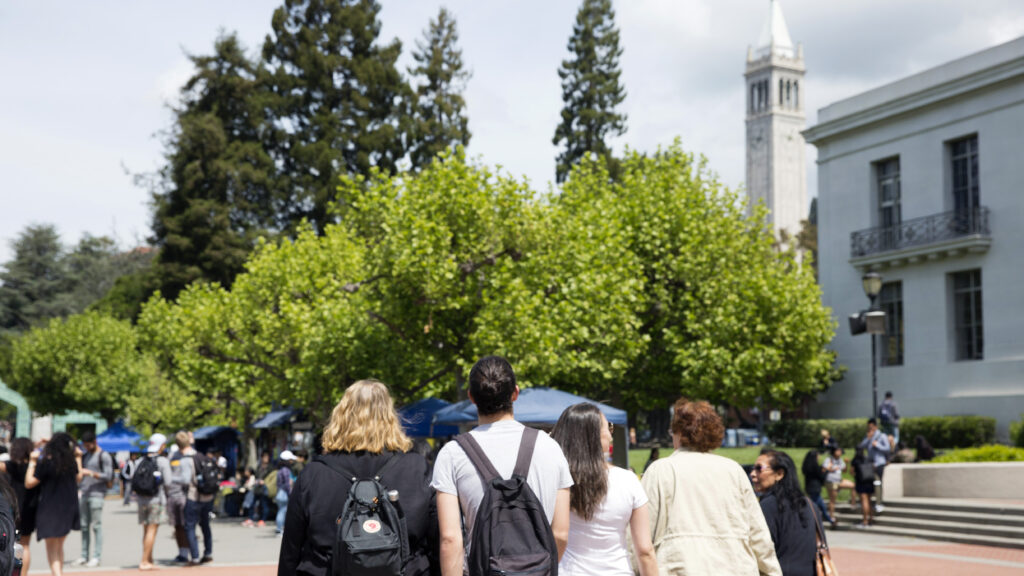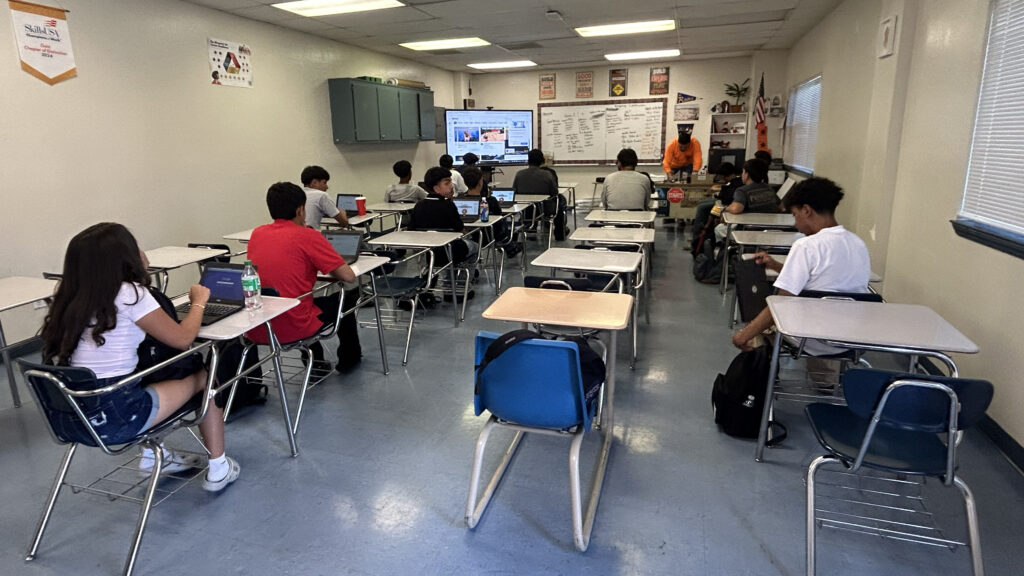

Kids get a chance to stretch their legs and skills during physical exercise in Los Angeles in 2023.
Courtesy LA84 Foundation
Millions of young people across the nation have returned to school, yet students are still struggling to navigate the return to normal. Research shows us that educators and policymakers can bring back joy in schools by prioritizing sport and play to build a supportive learning environment. One where we all win.
The role of sports and play extends far beyond physical fitness. It profoundly impacts student social and emotional health and school connectedness. By instilling valuable life skills, fostering social bonds and promoting emotional well-being, sport and play contribute to a holistic educational experience that nurtures well-rounded individuals capable of transcending life’s challenges and thriving in diverse circumstances.
With parents, educators and administrators now back in school, let’s not forget the Covid-19 pandemic ushered in a new set of challenges for youth, leading to a mental health crisis as declared by the U.S. Surgeon General in late 2021.
While issues concerning the mental health of our kids had arisen long before the pandemic, nearly three years of isolation and increased screen time, death and uncertainty only magnified students’ stress, anxiety and depression. We warned this was a mounting mental health emergency in schools last year, but today it is in clearer focus. Results released in February from the Centers for Disease Control and Prevention’s Youth Risk Behavior Survey indicated startling trends. Nearly 3 in 5 teen girls (57%) said they felt “persistently sad or hopeless.” More than 40% of boys and girls responded they had felt so sad or hopeless within the past year they were unable to perform regular activities.
According to a 2022 State of Youth Mental Health report which surveyed 2,000 parents, 68% have seen their children face significant mental and emotional challenges. Yet, recent studies have also found 60% of youth with major depression do not receive mental health treatment, many of them youth of color.
These findings require us to not rush into school with a singular focus on closing the learning loss. Let’s instead look to accelerate opportunities through sport and play to help our kids reconnect to themselves, to their friends and to their schoolwork.
Sport and play hold a profound significance in fostering social and emotional well-being and enhancing school connectedness for students. Beyond mere physical activity, engagement in sport and play cultivates essential life skills and nurtures interpersonal relationships.
Policymakers across the country have recognized the value of sport and play in schools and are advancing this framework. California state Sen. Josh Newman authored Daily Recess for All, Senate Bill 291, which ensures students have access to a 30-minute recess for unstructured play and that it cannot be withheld as a form of punishment.
The joy and spontaneity inherent in play promote emotional release and stress reduction. Engaging in recreational activities allows students to unwind, alleviate anxiety and recharge their mental faculties. This, in turn, equips them to navigate academic pressures and personal trials more effectively. One study found that 6-to-8-year-olds who exercised frequently had fewer symptoms of major depressive disorders two years later.
This same study found 73% of parents believe that sport benefits their child’s mental health. Participating in sports teaches invaluable lessons in teamwork, communication and perseverance. Through wins and losses, individuals learn to handle success and setbacks, building resilience and boosting self-esteem. These experiences translate into the ability to cope with challenges outside the sports arena, contributing to a balanced social and emotional state.
Sports and play serve as powerful catalysts for building social bonds. Students develop a sense of camaraderie and shared purpose in collaborative activities, breaking down barriers and forming connections that transcend differences. This inclusivity enhances the feeling of belonging, which is vital for a positive school environment.
In a world increasingly driven by digital interactions, the physicality of sports and play offers a refreshing counterbalance. Face-to-face interactions during games and playtime nurture emotional intelligence and empathy, enriching interpersonal skills that are essential for healthy relationships in school — and later in life.
Although it’s never been more needed in the educational environment, many public schools have defunded sports programs and offer physical education far less than they once did. That reinforces the pay-to-play model and leaves out the kids who have the least.
Our data shows that as household income increases in LA County, so does activity levels for the children in the home. Children from homes with income under $35,000 a year play far less than kids from affluent households, and they are unable to access the resources they need to be active.
These children are our future engineers, musicians, teachers, caregivers and leaders. Talent is universal, but opportunity is not. We can mend the kids’ lives who are suffering by providing access to the transformative power of sport and play, and help change a significant number of their destinies.
•••
Renata Simril is president & CEO of the LA84 Foundation, the legacy of the 1984 Summer Olympics in Los Angeles, and a national leader advocating for the role of sport and play in positive youth development.
The opinions expressed in this commentary represent those of the author. EdSource welcomes commentaries representing diverse points of view. If you would like to submit a commentary, please review our guidelines and contact us.

Generative AI is more than just a technological advancement—it’s a transformative force that is reshaping industries and redefining how businesses function. With AI-driven automation, organizations can streamline operations, enhance efficiency, and deliver personalized customer experiences. From virtual assistants to AI-generated content, the applications of generative AI are limitless. As businesses embrace digital transformation, understanding the role of AI-powered systems becomes crucial for long-term success. In this blog, we’ll dive deep into why generative AI is important, how it is impacting businesses, and what the future holds for this groundbreaking technology.


UC Berkeley students on campus on Sather road in Berkeley.
Credit: Alison Yin / EdSource
Patrick Acuña entered the University of California, Irvine as an undergraduate. In recovery from methamphetamine and heroin usage, he entered the UC system with the hope of being supported while he was starting a new academic and social journey. Acuña said maintaining his recovery is vital to him because he knows for sure he “doesn’t want to go back to what once was” — staying up for days on end when he was in active addiction.
The normalization of drinking, substance use and other potentially harmful behaviors campuses is a scary reality for folks in recovery. This disconnect from healthier peers can be isolating and damaging, especially because community can serve as an essential support system. For students entering college, this, in addition to academic stress, new financial responsibilities and more, can increase the risk of relapse.
But on-campus collegiate recovery programs can help students navigate these pressures as part of the continuum of care that is essential to maintaining and solidifying recovery.
Unfortunately, UC Irvine lacked a collegiate recovery program that could have supported Acuña in these challenges. Currently, only six out of the 10 UC campuses have a developing or established collegiate recovery program. The programs that do exist vary widely in their staffing capacity and the range of services they provide.
This discrepancy must be addressed; collegiate recovery programs systemwide should be staffed with at least one full-time staff member, a dedicated and safe physical space and institutional funding.
Trey Murray, an undergraduate student at UC Santa Barbara, said, “I remember coming to UCSB, a quarter behind all the other freshmen because I spent the summer in a treatment center. I was terrified of college as a whole and especially scared of navigating school while staying sober. (The collegiate recovery program) provided me with a safe and recovery-supportive environment that was crucial to my success in school and sobriety. (It) gave me a place to fit in on campus and sparked joy and passion in my student life.”
Collegiate recovery programs provide resources such as substance-free social events, harm reduction supplies such as fentanyl test strips and the overdose medication naloxone, campuswide educational programming, recovery housing, referrals to higher levels of care, and support groups led by peers who are familiar with the social isolation and distinct difficulties of maintaining sobriety or reducing their usage in collegiate settings where substance use is a standard part of social experiences.
These programs are a vital support for students in recovery from substance abuse, other behavioral addictions, eating disorders and similar conditions. According to a report from the federal Substance Abuse and Mental Health Services Administration, 1 in 7 people aged 18 to 25 meets the diagnostic criteria for a substance-use disorder. Among college students specifically, that number is closer to 1 in 4. Furthermore, data from the American College Health Association’s National College Health Assessment shows that students at every UC campus are using substances and seeking recovery-supportive communities.
For Acuña, integration of recovery into his everyday life was a much bigger challenge due to the lack of a collegiate recovery program on his campus. “I always have to be vigilant with my recovery; I wouldn’t ever say I have arrived at recovery,” he notes. He didn’t get the needed assistance a collegiate recovery program would have provided regarding hosting on-campus support groups, connecting him to clinicians, allowing him to find a supportive community of peers on campus, and providing an accessible, safe place to go when faced with stressors, activators or urges. Instead, he had to find ways to travel off campus and relied largely on other forms of peer support through student organizations and identity-based clubs such as Underground Scholars to have community and connection with his peers. These organizations, however, are not specifically geared for recovery.
An undergraduate student shared why they had chosen to attend UC Santa Cruz, which has a staffed and funded collegiate recovery program: “My biggest fear in coming to college was relapsing. Having (a collegiate recovery program) during my college experience with its substance-free events and programming, as well as support groups to meet people with shared experiences, has been tremendously helpful in my recovery.”
Recovery as a process is more taxing than a full-time job, as it requires constantly challenging the unhelpful coping mechanisms one has been using for so long, and collegiate recovery programs can support students especially well through their on-campus presence and support.
Preliminary research shows that collegiate recovery programs contribute to better academic outcomes. Data from Texas Tech University, which is home to one of the country’s oldest collegiate recovery programs, suggests that its members have higher graduation rates and higher GPAs than the general student body. Data collected from such programs nationwide show that participating students have almost a 90% graduation rate compared with a 61% institutionwide graduation rate.
As Esse Pink, a master’s student at UCLA, said, “Without the UCLA collegiate recovery program, my life trajectory would be far worse. I would not have stayed sober, I would not have graduated with my bachelor’s, I may not even be alive.”
•••
Aditi Hariharan is a third year student at UC Davis, majoring in both political science and nutrition science (public health emphasis). She served as the ACQUIRE vice chair on behalf of the UC Student Association in 2023-24.
The opinions expressed in this commentary represent those of the author. EdSource welcomes commentaries representing diverse points of view. If you would like to submit a commentary, please review our guidelines and contact us.


Classrooms for career technical education are cramped, and the Wasco Union High School District hopes to expand them with Proposition 2.
Credit: Emma Gallegos / EdSource
After decades of disinvestment and neglect, it’s clear that California’s schools are in desperate need of repair. Many school districts across the state are struggling with dilapidated buildings, old classrooms and unsafe conditions for their students.
According to a recent report from the Public Policy Institute of California, 38% of K-12 students in California are enrolled in schools that don’t meet our state’s minimum safety standards. This is obviously dangerous and completely unacceptable. Unsurprisingly, countless studies have shown that bad environmental conditions — including dirty air, lack of light and lack of safe building facilities — significantly decrease students’ academic achievement.
Unfortunately, with no dedicated resource pool and no new state school bond measures in almost a decade, California is almost out of money for school repairs. Unlike many other states, California does not have a dedicated funding stream for investments in school facilities, which makes districts across the state entirely reliant on raising money from state or local bonds for facility upgrades.
As a result, California’s school repair fund is expected to be depleted by this upcoming January, which would leave countless schools across the state without any ability to repair or upgrade their resources, sans a well-resourced PTA or local bond measure providing the funding. Wealthier districts might be able to skate by, but districts in low-income communities would be devastated.
As state superintendent of public instruction, I’ve overseen the administration of billions of dollars for K-12 school construction and modernization that came from the last state bond, but these funds were only a drop in the bucket that just scratched the surface of California’s immense needs and were depleted quickly.
That’s why Proposition 2, a bond measure this November that would provide $8.5 billion in facility renovations for TK-12 schools and $1.5 billion for community colleges, couldn’t come at a more urgent time. It’s a vitally necessary, common-sense step forward to provide critically needed upgrades to California’s schools.
To receive state bond money, districts must attempt to raise a local bond of their own and then apply to the State Facilities Program for a funding match — though districts that are unable to raise more than $15 million from a local bond can receive up to a 100% match.
The measure, along with the accompanying local bonds, would help upgrade facilities at public elementary, middle and high schools and community colleges across California to build more classrooms, modernize science labs, enhance gymnasiums, build performing arts centers, and replace aging buildings.
But most critically, Proposition 2 would help ensure basic 21st-century facility standards in every school across the state — helping low-income districts receive desperately needed funding to repair heating and air conditioning systems, repair leaky roofs, and remediate hazardous black mold. Some of the money is also earmarked for removing lead from water, creating transitional kindergarten classrooms and building career and technical education facilities.
Significantly, this proposal also includes significant equity-focused improvements to existing policy that would ensure this funding goes to the districts that most need it. Proposition 2 improves how state funds are distributed to school districts across the state, making it more equitable for less-affluent districts and those with higher numbers of English learners and foster youth.
Ten percent of the funds would be dedicated to small school districts that currently struggle to amass the funding for facility upgrades, and the formula for allocating state funding establishes a higher match to low-wealth districts that cannot afford to generate much local funding, as well as those with a high percentage of disadvantaged students.
Without Proposition 2, schools districts in smaller and lower-income areas would have no other way to pay for these critical improvements, as they struggle tremendously to raise enough local bond money to pay for school repair, making them completely reliant on funding from state bonds for facility repairs.
Additionally, while not the focus of the measure, the investments provided by Proposition 2 will also create tens of thousands of good-paying construction jobs across the state, which will boost local economies.
Ultimately, California’s schools have a desperate need to modernize our buildings, facilities and campuses, and the money needed to make the necessary repairs has been exhausted. Proposition 2 will provide an infusion of vitally important investments to our schools that will address the significant backlog of districts hoping to receive funding for repairs, and considerably improve the conditions of students across the state.
•••
Tony Thurmond is California’s superintendent of public instruction and a candidate for governor in 2026.
The opinions expressed in this commentary represent those of the authors. EdSource welcomes commentaries representing diverse points of view. If you would like to submit a commentary, please review our guidelines and contact us.